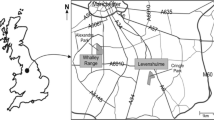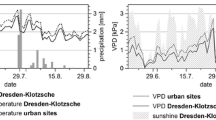Abstract
The role of trees in city cooling has warranted much attention based on concerns over climate change and urban expansion. Simultaneously, there is an interest in introducing species from dry habitats to cope with the increasing risks of drought under climate change. The general understanding is that the evolutionary adaptation to respective resource supplies in species’ habitats affects their environmental tolerance. The physical performances of six frequently planted species, originating from two contrasting habitats, were tested in a drought experiment. We (1) investigated if species from drier habitats are more drought tolerant than species that have evolved in Central European woodlands under a temperate climate regime and (2) discussed the effect of tolerance on the cooling potential of these trees. Native species from mesic habitats maintained only 48% of their controls sap flux and of these species, Tilia cordata had the worst performance with premature leaf senescence. Species from drier habitats had less reduction in sap flux (60%) but lower stem growth, possibly favouring (fine) root development into deeper soil layers, as observed when comparing linden species. Higher stem water exploitation and stronger regulation of water use at high evaporative demand were further reaction patterns that likely helped species from dry habitats maintain good physiological functions. Therefore, even under sustained drought, we expect them to have a higher cooling capacity. As a conclusion, they should be favoured for planting in extreme urban environments. Systematic screening and testing of promising species from target habitats is recommended to diversify the choice of species.





Similar content being viewed by others
References
Armson D (2012) The effect of trees and grass on the thermal and hydrological performance of an urban area dissertation, University of Manchester
Armson D, Stringer P, Ennos AR (2012) The effect of tree shade and grass on surface and globe temperatures in an urban area. Urban For Urban Green 11:245–255. https://doi.org/10.1016/j.ufug.2012.05.002
BBCH (2001) Entwicklungsstadien mono- und dikotyler Pflanzen. BBCH Monografie. https://doi.org/10.5073/bbch0514
Chapin FS III, Autumn K, Pugnaire F (1993) Evolution of suites and traits in response to environmental stress. Am Nat 142:78–92. https://doi.org/10.1086/285524
Choat B, Jansen S, Brodribb TJ, Cochard H, Delzon S, Bhaskar R, Bucci SJ, Field TS, Gleason SM, Hacke UG, Jacobsen AL, Lens F, Maherali H, Martínez-Vilalta J, Mayr S, Mencuccini M, Mitchell PJ, Nardini A, Pittermann J, Pratt RB, Sperry JS, Westoby M, Wright IJ, Zanne AE (2012) Global convergence in the vulnerability of forests to drought. Nature 491:752–755. https://doi.org/10.1038/nature11688
Duhme F, Pauleit S (2000) The dendrofloristic richness of SE-Europe, a phenomenal treasure for urban plantings. Mitteilungen aus der Biologischen Bundesanstalt für Land- und Forstwirtschaft Berlin-Dahlem 370:23–29
DWD (2018) www.dwd.de. Accessed 15 March 2018
Endlicher W, Jendritzky G, Fischer J, Redlich JP (2008) Heat waves, urban climate and human health. In: Marzluff JM et al (eds) Urban ecology. Springer, Boston, pp 269–278
Esri (2014) ArcGIS
Ewers BE, Oren R, Johnsen KH, Landsberg JJ (2001) Estimating maximum mean canopy stomatal conductance for use in models. Can J For Res 31:198–207. https://doi.org/10.1139/x00-159
Fini A, Ferrini F, Frangi P, Amoroso G, Piatti R (2009) Withholding irrigation during the establishment phase affected growth and physiology of Norway maple (Acer platanoides) and linden (Tilia spp.). Arboricult Urban For 35:241–251
GALK (2018) GALK-Straßenbaumtest 1 and 2. www.galk.de. Accessed 01 March 2018
Gill SE, Handley JF, Ennos AR, Pauleit S (2007) Adapting cities for climate change: the role of the green infrastructure. Built Environ 33:115–133
Gillner S, Vogt J, Tharang A, Dettmann S, Roloff A (2015) Role of street trees in mitigating effects of heat and drought at highly sealed urban sites. Landsc Urban Plan 143:33–42. https://doi.org/10.1016/j.landurbplan.2015.06.005
Gillner S, Korn S, Hofmann M, Roloff A (2017) Contrasting strategies for tree species to cope with heat and dry conditions at urban sites. Urban Ecosyst 20:853–865. https://doi.org/10.1007/s11252-016-0636-z
Granier A (1987) Evaluation of transpiration in a douglas-fir stand by means of sap flow measurements. Tree Physiol 3:309–319
Hiemstra JA (2011) Straßenbaumtest in den Niederlanden. Veitshöchheimer Berichte 152:37–41
Kiermeier P (1995) Die Lebensbereiche der Gehölze eingeteilt nach dem Kennziffernsystem. Pinneberg
Klein T (2014) The variability of stomatal sensitivity to leaf water potential across tree species indicates a continuum between isohydric and anisohydric behaviours. Funct Ecol 28:1313–1320. https://doi.org/10.1111/1365-2435.12289
Köhler M (2010) Cacao agroforestry under ambient and reduced throughfall – tree water use characteristics and stand water budgeting. Dissertation, University of Göttingen
Kunz J, Räder A, Bauhus J (2016) Effects of drought and rewetting on growth and gas exchange of minor European broadleaved tree species. Forests 7:239. https://doi.org/10.3390/f7100239
Larcher W (2001) Ökophysiologie der Pflanzen. Ulmer Verlag, Stuttgart
Lechowicz MJ (1984) Why do temperate deciduous trees leaf out at different times? Adaptation and ecology of forest communities. Am Nat 124:821–842. https://doi.org/10.1086/284319
LWG (2018) Forschungsprojekt Stadtgrün 2021. Neue Bäume braucht das Land. www.lwg.bayern.de. Accessed 26 April 2018
McCarthy HR, Pataki DE, Jenerette GD (2011) Plant water-use efficiency as a metric of urban ecosystem services. Ecol Appl 21:3115–3127. https://doi.org/10.1890/11-0048.1
Moser A, Rahman MA, Pretzsch H, Pauleit S, Rötzer T (2017) Inter- and intraannual growth patterns of urban small-leaved lime (Tilia cordata mill.) at two public squares with contrasting microclimatic conditions. Int J Biometeorol 61:1095–1107. https://doi.org/10.1007/s00484-016-1290-0
Niinemets Ü, Valladares F (2006) Tolerance to shade, drought, and water logging of temperate northern hemisphere trees and shrubs. Ecol Monogr 76:521–547. https://doi.org/10.1890/0012-9615(2006)076[0521:TTSDAW]2.0.CO;2
Oren R, Sperry JS, Katul GG, Pataki DE, Ewers BE, Phillips N, Schäfer KVR (1999) Survey and synthesis of intra- and interspecific variation in stomatal sensitivity to vapour pressure deficit. Plant Cell Environ 22:1515–1526. https://doi.org/10.1046/j.1365-3040.1999.00513.x
Peters EB, McFadden JP, Montgomery RA (2010) Biological and environmental controls on tree transpiration in a suburban landscape. J Geophys Res 115:G04006. https://doi.org/10.1029/2009JG001266
R Core Team (2014) R: A language and environment for statistical computing
Rahman MA, Moser A, Rötzer T, Pauleit S (2017a) Microclimatic differences and their influence on transpirational cooling of Tilia cordata in two contrasting street canyons in Munich, Germany. Agric For Meteorol 232:443–456. https://doi.org/10.1016/j.agrformet.2016.10.006
Rahman MA, Moser A, Rötzer T, Pauleit S (2017b) Within canopy temperature differences and cooling ability of Tilia cordata trees grown in urban conditions. Build Environ 114:118–128. https://doi.org/10.1016/j.buildenv.2016.12.013
Roloff A (2013) Stadt- und Straßenbäume der Zukunft – Welche Arten sind geeignet? Aktuelle Fragen der Stadtbaumplanung, -pflege und -verwendung, Forstwissenschaftliche Beiträge Tharandt Beiheft 14:173–187
Roloff A, Bärtels A (2006) Flora Der Gehölze – Bestimmung, Eigenschaften Verwendung. Ulmer Verlag, Stuttgart
Roloff A, Grundmann B, Korn S (2013) Trockenstress-Toleranz bei Stadtbäumen – Anpassungs- und Schutzstrategien/Arteneignung. In: Dujesiefken D (ed) Jahrbuch der Baumpflege, 2013. Haymarket Media, Braunschweig, pp 173–185
Shashua-Bar L, Hoffmann ME (2000) Vegetation as a climatic component in the design of an urban street: an empirical model for predicting the cooling effect of urban green areas with trees. Energy Build 31:221–235. https://doi.org/10.1016/S0378-7788(99)00018-3
Sjöman H, Gunnarsson A, Pauleit S, von Bothmer R (2012) Selection approach of urban trees for inner-city environments: learning from nature. Arboricult Urban For 38:194–204
Stratopoulos LMF, Duthweiler S, Häberle K-H, Pauleit S (2018) Effect of native habitat on the cooling ability of six nursery-grown tree species and cultivars for future roadside plantings. Urban For Urban Green 30:37–45. https://doi.org/10.1016/j.ufug.2018.01.011
Acknowledgements
We thank the heads and staff members of the municipal nursery of Munich-Laim for their support and encouragement to conduct our field study there. The authors would also like to express their gratitude to Felix Seebauer and Jonas Schweiger for their assistance in field data collection. This work was supported by the Bavarian State Ministry of Education, Cultural Affairs, Science and Arts, Munich, Germany [VIII.2-F1116.WE].
Author information
Authors and Affiliations
Corresponding author
Ethics declarations
The experiments comply with the current laws of Germany.
Conflict of interest
The authors declare that they have no conflict of interest.
Rights and permissions
About this article
Cite this article
Stratópoulos, L.M.F., Zhang, C., Duthweiler, S. et al. Tree species from two contrasting habitats for use in harsh urban environments respond differently to extreme drought. Int J Biometeorol 63, 197–208 (2019). https://doi.org/10.1007/s00484-018-1653-9
Received:
Revised:
Accepted:
Published:
Issue Date:
DOI: https://doi.org/10.1007/s00484-018-1653-9




